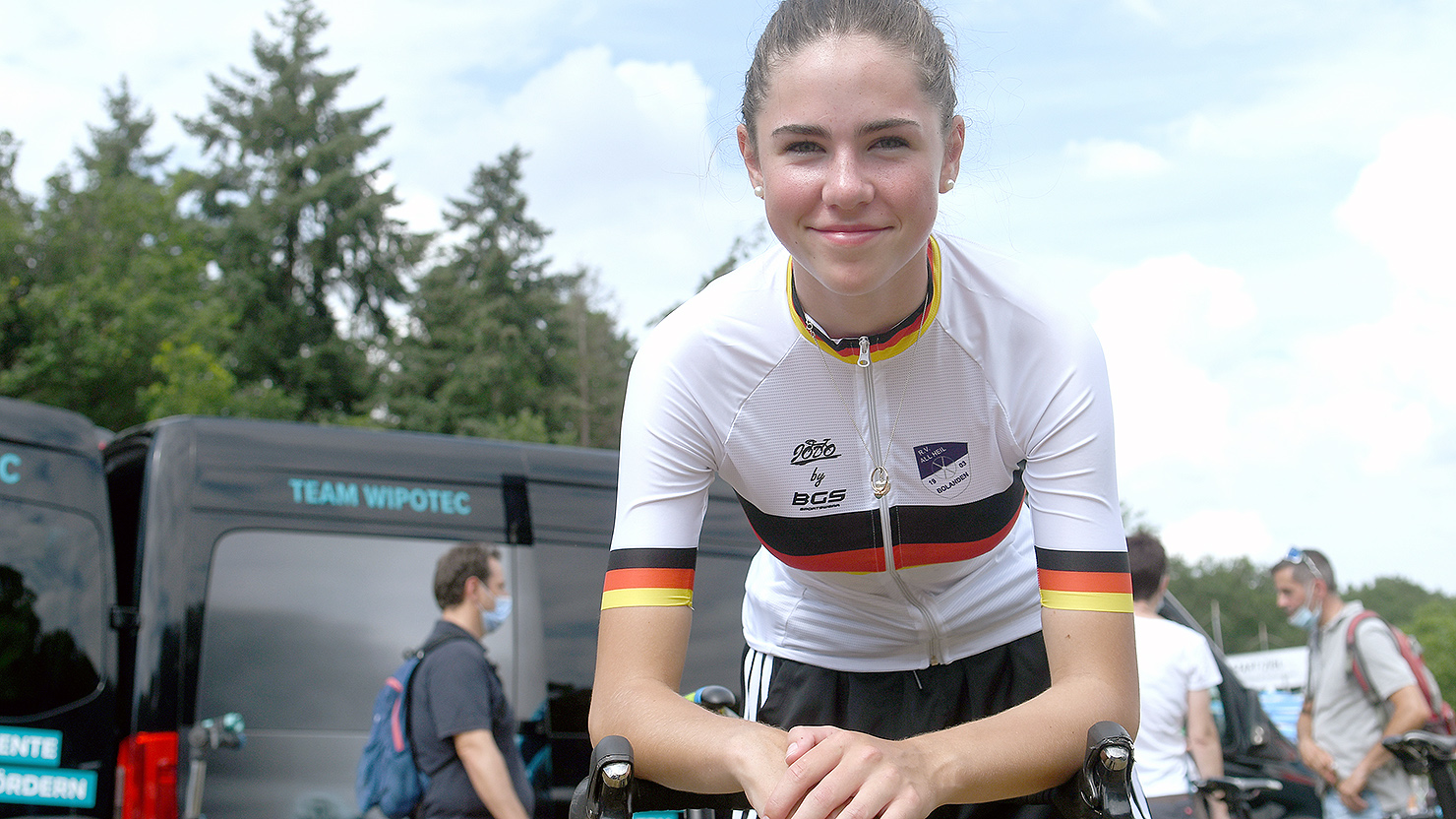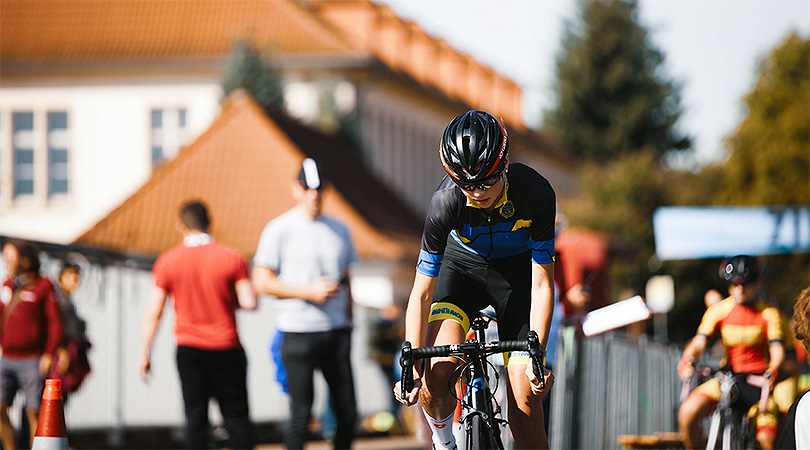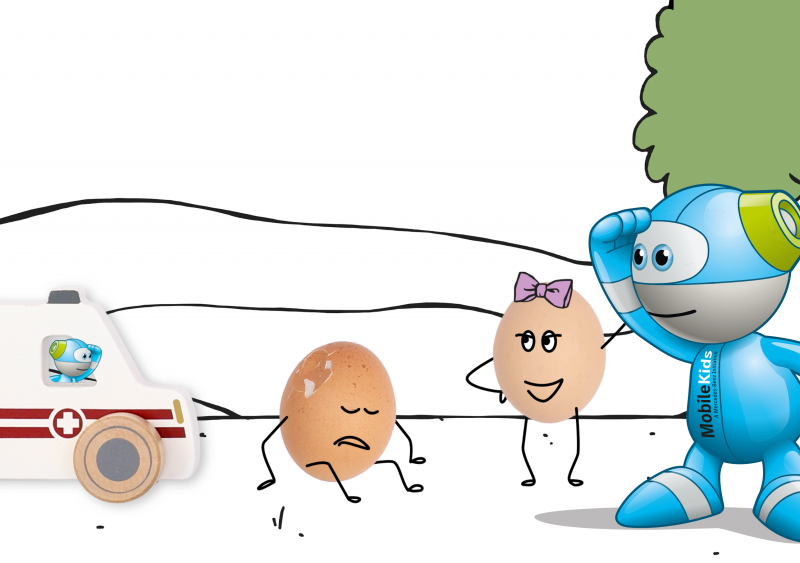Black-red-gold stripes on a white jersey, that was Magdalena Leis' trademark for most of the 2021 cycling season. A clear indication that not just any young athlete is pedalling here, but the reigning German champion - in the pupils' class (U15). This year, the 14-year-old from RSC Linden (Rhineland-Palatinate) is already competing in the youth category (U17). While she races on closed-off tracks, in her training grounds in the Palatinate Forest she rides alongside cars and motorbikes. MobileKids asked her how she takes care of her safety.
Hello Magdalena, you are one of the best young cyclists in Germany. What fascinates you about the sport?
I loved cycling as a child. I got the idea of competing in races through a friend from primary school. He once took me to training about five years ago. I enjoyed riding with the others and the coaches so much that I stayed on. Through the races and the training camps, we naturally also get around a lot and see many new areas. Before the coronavirus pandemic broke out, we even went abroad from time to time. That doesn't happen so often now though. But the Black Forest is also a good cycling region.
Since you are so successful, you must train a lot, right?
In total, there are five or six training rides on the bike per week. Four with the training group at the sports high school in Kaiserslautern and then on the weekends I ride once or twice on my own. A session on the bike lasts about two hours. Then there is the stabilisation and strength training. It all takes up a lot of time.
How do you design your training routes? Do you choose roads with less traffic?
For the after-school sessions, our club coaches always go along and set the routes. They make sure that we drive on routes with less traffic. If there is a cycle path parallel to the road, we prefer to stay on it. I also use this as a guide when I'm on my own. I avoid busy roads. I still have quite a lot of respect for roads, despite the frequent training.
Are there situations you are afraid of?
You should not be afraid in traffic, but always respectful. If you are a cyclist on the road, you are never in control of what happens. Of course, I ride on the edge for safety. But there are always drivers who overtake too fast and too closely. Therefore, respect for the situation is very important because it sharpens the perception for the road.
How does this respect affect your behaviour?
It starts with the fact that I always obey the traffic rules. In addition, I ride far enough out so that I don't obstruct motorists, but can still be easily seen by them. In bends, it is important not to swerve too far into the centre of the lane.

1. Hand signal
When turning, always make the hand signal in good time.
2. Cycle path
Always ride on the cycle path if it is in good order.
3. No fear
Respect for cars and buses is important, but you must not be afraid either. It only makes you nervous and that leads to mistakes.
4. Clothes
Always remember to wear the right clothes. They should be as bright as possible and equipped with reflectors.
Your training is exhausting. Do you still have a free mind to pay attention to all these things?
We do ride at a high heart rate during road training, but mostly in the basic endurance range. So that you can still talk and drink without any problems. We are still far from our breaking point. Through constant training, I have also gone through the sequences so often that I now observe them almost automatically.
Do you dress in a way that makes you easily recognisable?
In fact, I always pay attention to that, especially in winter. At these times the coaches even tell us that we have to wear eye-catching clothing. Our clubs provide us with jackets with bright neon colours for the dark season. Good cycling clothes should always be bright and have reflectors so that you can really be seen. We also always have to have the lights on our bikes in winter, even if we know beforehand that we probably won't need them.
So you also train in the dark?
We try to avoid it. But since we don't have a track cycling hall in the immediate vicinity, we have to train outdoors a lot in winter too. If we notice that it is getting dark before the end of the session, we go home earlier. The rest we do indoors on the roller trainer.
Are you specially trained for training on the road?
Like every child, I also did my bicycle riding licence in primary school. However, before we start cycling training, most of us get another briefing on all the issues that need to be considered when cycling on the road. It takes a while until everything is automated and you actually always make the hand signal when turning. But that's why one of our coaches always rides behind us and points out when we do something wrong.
You talked about cycle paths. Many adult road cyclists seem to find them too bad, so they always use the road. What's your view on this?
If there are a thousand broken pieces lying around or the road surface is extremely bad, then I wouldn't ride there either. Here in the Palatinate Forest, however, the cycle paths are mostly in good order and clean. If there is ever any broken glass lying around, we simply avoid it. If the cycle paths are in good condition, I think it is important to ride on them.

The Road Traffic Regulations (StVO) and the Road Traffic Licensing Regulations (StVZO) lay down all the rules for cycling on roads. Now they apply equally to all cyclists. To date, however, there are regulations that apply to everyone, but from which racing cyclists benefit in particular.
1.) Until the amendment of the Road Traffic Licensing Regulations in 2017, only bicycles weighing less than 11 kg - i.e. mainly racing bikes - were allowed to be ridden during the day even without lights. With the amendment of § 67 StVZO, however, this was transferred to all bicycles. Since then, it is generally permitted to cycle without lights if there is sufficient light. Removable and battery-powered headlights are therefore permitted. However, they must be put on as soon as dusk sets in, if it is completely dark or the weather restricts visibility.
2.) If blue cycle path signs (signs 237, 240 and 241) indicate this, the obligation to use the cycle path also applies to road cyclists. However, as soon as a group of cyclists consists of more than 15 people, it is considered a column according to §27 of the StVO. Two people are then allowed to ride side by side and on the road. What is rare in ordinary cycling tours does happen in training groups in road cycling.
3.) A column of cyclists must remain in a single formation because it is considered to be one vehicle. As soon as the head of the formation passes an intersection when the road is clear, all members must follow, even if in the meantime the traffic lights change to red or a vehicle comes out of the road that has the right of way.








